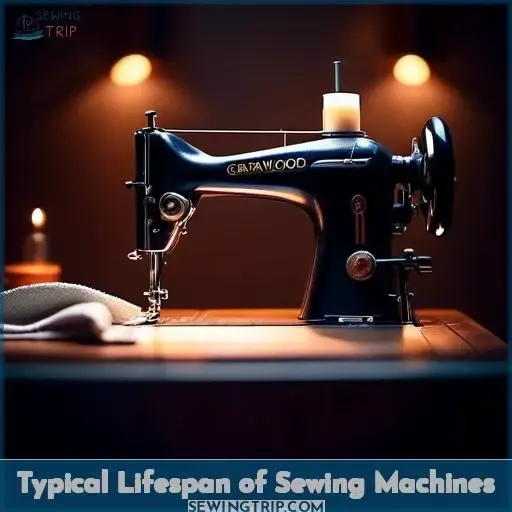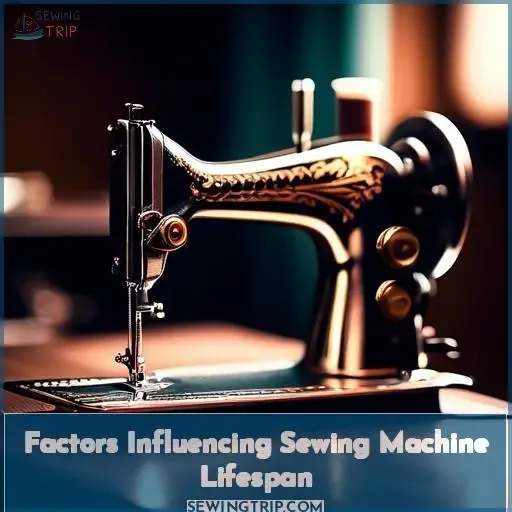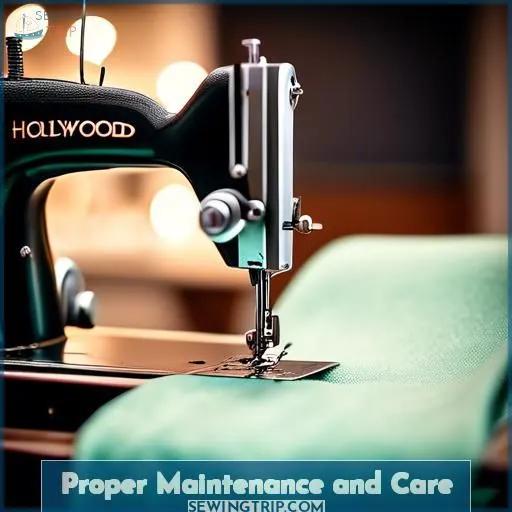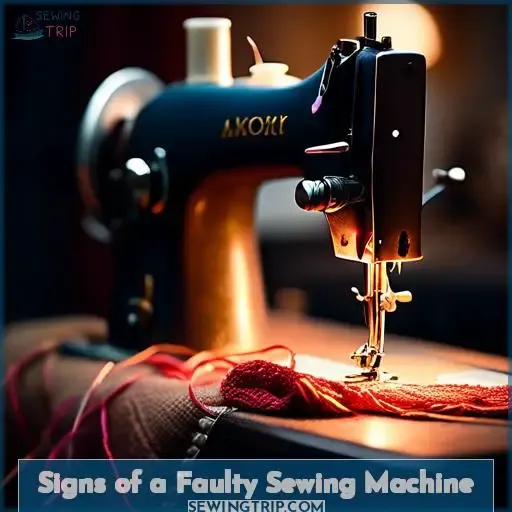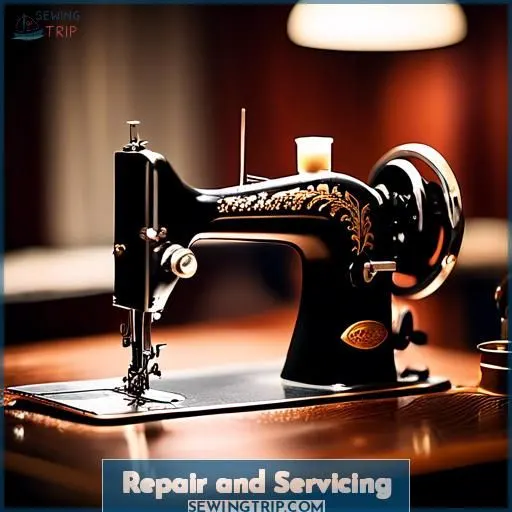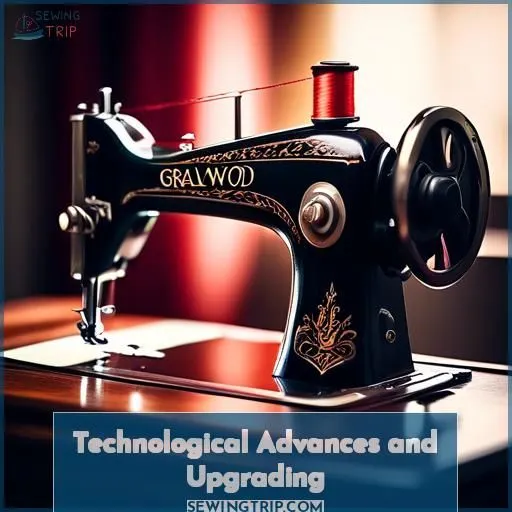This site is supported by our readers. We may earn a commission, at no cost to you, if you purchase through links.
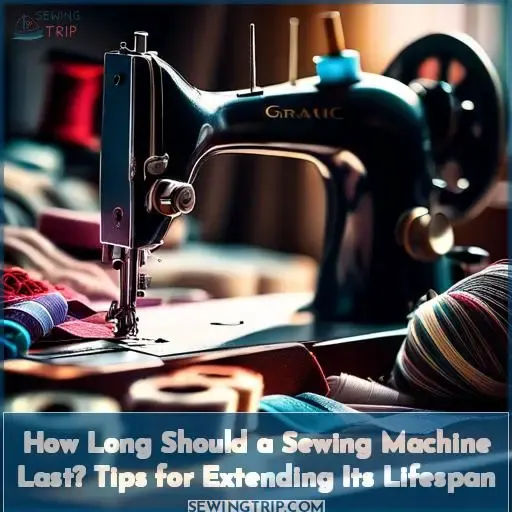 Sewing machines deserve care to maximize their lifespan. With proper maintenance, quality machines can operate for decades.
Sewing machines deserve care to maximize their lifespan. With proper maintenance, quality machines can operate for decades.
This guide explains factors affecting how long a sewing machine lasts and shares tips to extend its life through cleaning, oiling, repair, and eventual upgrading.
You’ll gain insights to identify signs of wear, understand when professional servicing is needed, and learn about technological advances that may necessitate an upgrade – empowering you to get maximum value from your sewing investment.
Table Of Contents
Key Takeaways
- High-quality sewing machines with proper maintenance can last for decades, while cheaper models may need to be replaced more often.
- Proper storage, high-quality parts, and regular maintenance are crucial for a sewing machine’s longevity.
- Technological advancements and compatibility with newer systems can necessitate an upgrade.
- Regular maintenance and care, such as cleaning, lubricating gears, and servicing, can help extend a sewing machine’s lifespan.
How Long Should a Sewing Machine Last?
A sewing machine’s lifespan can vary, but in general, they are known to last well over five years and sometimes up to 25 years. However, the environment and maintenance play a significant role in its longevity.
Proper storage and regular cleanings can extend the life of a sewing machine. High-quality materials and maintenance practices from reputable brands can also contribute to a longer lifespan.
Typical Lifespan of Sewing Machines
The typical lifespan of a sewing machine varies depending on factors such as usage, storage, brand reputation, material quality, and maintenance.
On average, a sewing machine can last between 5 and 25 years.
However, with proper care and maintenance, some high-end models can last up to 10-15 years.
Sewing machine depreciation is also a factor, with an average rate of 15%.
Replacement parts can be crucial for extending the lifespan of a sewing machine, especially for machine embroidery clubs that rely on specialized equipment.
In the realm of sewing, it’s not merely about the machine’s lifespan; it’s about how well it performs and how compatible it is with your needs.
Factors Influencing Sewing Machine Lifespan
Many factors affect how long your sewing machine will last, including how it’s used, maintained, and the quality of its construction. High-quality machines with proper upkeep can last for decades, while cheaper models may need to be replaced more often.
Factors Affecting Sewing Machine Lifespan
Just like a well-oiled car, your sewing machine’s lifespan hinges on a few key factors.
- Storage Savvy: Keep it covered to dodge dust and dampness.
- Material Matters: Quality parts mean fewer oops moments.
- Tech-Savvy Upkeep: Embrace regular servicing and tension tweaks to stay in the stitch game.
High-Quality Construction and Maintenance
To ensure a sewing machine’s longevity, it’s crucial to prioritize high-quality construction and regular maintenance.
This involves keeping a maintenance schedule, ensuring the oil quality is top-notch, and storing the machine in suitable conditions.
Spare parts and compatibility with newer systems are also vital for continued use.
Regularly oiling the machine and maintaining the bearings can help prevent issues.
High-quality construction and maintenance underpin the machine’s robustness, allowing it to withstand the complexities of the ever-evolving world of sewing technology.
Technological Advancements and Compatibility
Navigating the complexities of technological advancements and compatibility can be daunting, especially when it comes to sewing machines.
As your sewing machine ages, it may become obsolete due to incompatibility with newer operating systems or the lack of spare parts for peripherals like printers or embroidery machines.
This isn’t only true for sewing machines, but also for other devices.
It’s advisable to keep your machine updated and compatible with the latest technological advancements, such as those found in Janome or other machine embroidery machines.
Proper Maintenance and Care
To extend the lifespan of your sewing machine, proper maintenance and care are crucial.
-
Store it correctly: Keep your machine in a cool, dry place away from direct sunlight. Use a cover to protect it from dust and debris.
-
Choose the right materials: Use high-quality thread and needles designed for your machine. Avoid using cheap or damaged materials that can cause damage.
-
Regular maintenance: Clean your machine regularly, lubricating gears, bushings, wicks, and led lighting with designated oil. Have it serviced yearly to replace worn-out parts like ac flex foot and check for any issues.
Signs of a Faulty Sewing Machine
As a sewing machine owner, it’s crucial to know the signs of a faulty sewing machine. Electrical faults, physical damage, thread tension issues, needle breakage, and bobbin issues can all indicate that your machine needs attention.
To help you navigate the complexities of sewing machine maintenance, we’ve created a table that outlines common issues and their potential causes. For example, if your machine is skipping stitches, it could be due to thread tension issues or a worn-out needle.
Or, if your quilting project isn’t coming together as planned, it might be due to feed dogs that aren’t working properly.
In the realm of sewing, there’s always something new to learn. Whether you’re seeking more than just the basics or trying to unlock the secrets of your Janome or other sewing machine, it’s essential to stay attuned to your machine’s needs.
Regular maintenance and care can help extend its lifespan and keep it running smoothly.
Repair and Servicing
When it comes to maintaining your sewing machine, ensuring parts availability, considering repair costs, and technician expertise are key.
Regular servicing not only extends the lifespan of your machine but also prevents costly repairs down the line.
Understanding warranty options and investing in preventative maintenance can save you from unexpected breakdowns.
Whether you own a Janome Skyline S5, Janome Horizon MC15000 Quiltmaker, Janome Memory Craft 11000, or Janome MC 6700P, taking care of your machine with an AC Flex Foot can make a significant difference.
Don’t overlook the importance of timely servicing and proper care to keep your sewing machine running smoothly for years to come.
Technological Advances and Upgrading
In the ever-evolving world of sewing technology, it’s essential to keep up with the latest advancements to ensure your sewing machine remains compatible and functional. As technology progresses, older machines may become obsolete, leading to incompatibility with newer systems and software updates.
Obsolescence is a natural part of any technology’s lifecycle. In the realm of sewing machines, it’s not uncommon for machines over 20 years old to still function, but their compatibility with newer systems can be a significant issue.
For instance, some printers may not work with Windows 10, and scanner compatibility is crucial for continued use.
Moreover, the availability of spare parts for repair is vital. If a machine is no longer in production, finding compatible spare parts can be challenging. Mechanics may need to search for rare car parts, just as technicians may have spare parts for specific brands but not for older models.
To navigate these complexities, it’s essential to understand the compatibility of your sewing machine with the software and hardware you plan to use. This includes the operating system, the type of fabric you’ll be working with, and the specific tools and accessories you’ll need.
In the realm of sewing machines, technological advancements aren’t only about new features and capabilities but also about enhancing the user experience. For example, the DX-4000QVP offers features like a bobbin thread sensor and the visualization of stitches on the machine, making it easier to adjust stitch length and presser foot pressure.
It’s not merely about upgrading to a computerized or stand-up quilting machine; it’s about finding a machine that can grow with you. If you’re upgrading your machine, it’s advisable to consider factors like the size and weight of the machine, your workspace, and the features and accessories that will best suit your sewing projects.
In conclusion, understanding the technological advancements and compatibility of your sewing machine is crucial for its longevity. By keeping up with these trends, you can ensure your machine remains a reliable and effective tool for your sewing projects.
Frequently Asked Questions (FAQs)
How long do sewing machines last with regular maintenance?
With regular maintenance, you can expect a quality sewing machine to last 10-15 years, maybe more! Proper cleaning, lubrication, and tune-ups keep those gears humming.
What factors contribute to the longevity of a sewing machine?
You’ll get years of joy from your sewing machine if it’s well-built, meticulously maintained, and used properly. Don’t ignore small issues – nip ’em in the bud with professional servicing. Treat your machine like a beloved workhorse, not a disposable toy.
How does the brand and model of a sewing machine affect its lifespan?
You can expect top-tier brands like Bernina, Husqvarna Viking, and Pfaff to outlast cheaper models if properly serviced.
What are the common issues that can shorten the life of a sewing machine?
Lack of cleaning and lubrication, worn feed dogs, spoiled machine oil, and damaged parts like tension discs can drastically cut short a sewing machine’s prime years.
How often should a sewing machine be serviced for optimal performance and longevity?
Like a well-oiled machine, you’ll want to service your sewing companion yearly. Regular tune-ups keep needles humming and prevent frustrating snags or malfunctions.
Conclusion
Over 95% of sewing machine repairs involve simple maintenance.
By regularly cleaning, oiling, and servicing your machine, you can maximize its lifespan – many quality models last 25 years or more with proper care.
Stay vigilant for warning signs of wear.
Embrace technological upgrades when compatibility becomes an issue.
Invest in professional servicing to keep your sewing machine running smoothly for years to come.

